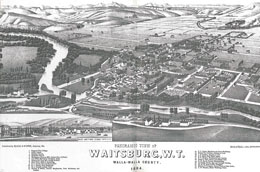On February 23, 1869, William Perry Bruce (1832-1916) files a plat for the town of Waitsburg. The town, which was officially named the previous year, has grown up around a flour mill established by Sylvester M. Wait (d. 1891) in 1865. The plat encompasses Main Street, extending south for a few blocks, with a few additional streets paralleling it. The population of the town is only about 100, but in the following decades the town will be connected with the regional railway system and both the mill and the town will grow. When the city is incorporated and chartered in 1881, the town's population will be approaching 400. By the end the nineteenth century, the expanded town's population will be more than 1,000.
Wait's Mill
In 1859, following a series of treaty negotiations and battles with local tribes, farmers and others began settling land at the juncture of the Touchet River and Coppei Creek. Initially these pioneer farmers raised some grain along the fertile banks of the rivers, but in the early 1860s they began dryland farming on the surrounding hills and started producing substantial quantities of wheat. After gold was discovered in the Clearwater region, a stagecoach line operating between Walla Walla and the new town of Lewiston connected the emerging farming community with the business of supplying miners. While in Lewiston selling supplies in 1864, Dennis Willard, who had claimed 160 acres near the Touchet and Coppei in 1859, met Sylvester M. Wait and convinced him to establish a flour mill on his land.
Willard (1832-1916) and William Perry Bruce donated land to Wait, and Wait obtained money and supplies to set up the mill on the north bank of the Touchet River. The famers held their wheat for Wait and his mill began operating in the spring of 1865. Wait sold half of his interest in the mill to the brothers William and Platt Preston and enlarged the mill. Soon a small village, which included a store, a school, a saloon, and a hotel, began to form across the river south of the mill. In 1866, William Nesbit Smith became the postmaster of the town and called it Delta. By popular vote, the town's name was changed to Waitsburg in 1868. In February 1869, Bruce filed a plat of the town encompassing Main Street, extending south from the mill for about five blocks, with a block to the west and two to the east.
Wait's Town
By 1870, Waitsburg had a population of 109 and included an assortment of businesses along Main Street and some 35 dwellings. In February 1881 the town was incorporated, but the town had to be reincorporated through a territorial charter later that year, in November. Between these two incorporations a rail line was extended through Waitsburg, which enabled more flour to be shipped out of the town and brought more people into it. As the city organized police, fire, water, and other public services, the mill was further expanded and updated. By 1890, Waitsburg's population was around 800. Main Street, which was by then lined with many brick buildings, was straightened and graded.
The town struggled through but survived the economic crisis of the mid 1890s, and by the turn of the century Waitsburg was established as a town principally focused on the storage, milling, and transportation of wheat and flour. During the early twentieth century, the town expanded farther to the south, away from the mill, and new commercial buildings were constructed. Wheat farming continued to be the core economic industry for the town, even after the closure of mill in 1957. In recent years, Waitsburg has attracted new attention as a destination for wine and food tourists.

